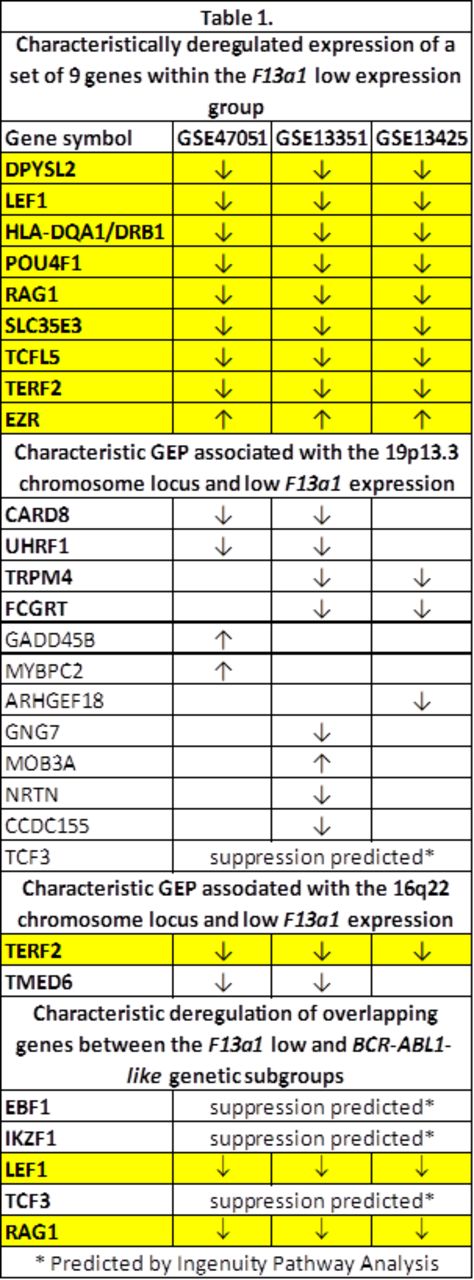Abstract
Background: Using multiparameter flow cytometry (FC), Western blot, ELISA and laser scanning microscopy, leukemic B-cell progenitor (BCP) lymphoblasts were identified as a novel expression site of coagulation factor XIII subunit A (FXIIIA; Kiss F. et al. Thomb Hemost, 2006.).
Objectives: The significance of FXIIIA expression, defined by FC, on the clinical outcome of children with BCP acute lymphoblastic leukemia (ALL) was studied. We used gene expression profile (GEP) analysis and pathway analysis to identify genes which may contribute to the phenotype of the F13a1 low expression patient subgroup. These genes will be tested for the presence of mutations by next generation sequencing in the next phase of the study.
Method: ALL immunophenotyping, including FXIIIA expression and detection of minimal residual disease (MRD) in Day 15 bone marrow was determined by four color FC analysis. Clinical course of FXIIIA-positive and –negative children with ALL was retrospectively studied and 3-yr overall survival (OS) data were calculated and compared by Kaplan-Mayer plot analysis. We analyzed 3 public datasets in the GEO Database (GSE47051, GSE13351 and GSE13425), including the dataset of the University of Padova (GSE47051) containing data on GEPs of children with ALL using GeneSpring and Ingenuity Pathway Analysis softwares.
Results: Sixty-three per cent of BCP ALL cases, investigated by FC at the Department of Laboratory Medicine, University of Debrecen expressed FXIIIA. Three-year overall survival (OS) of children with FXIIIA-positive ALL was significantly higher (87%) than 3-yr OS of patients with FXIIIA-negative ALL (65%). As expected, Day 15 FC-MRD successfully separated patients into three well-defined groups with different OS rates: 92%, 72% and 43% in FC-MRD SR, IR and HR groups, respectively. FXIIIA expression has merged FC-MRD SR and IR groups with a significant difference between FXIIIA-positive vs. -negative patients.
In the GeneSpring analysis, patients were separated into two groups: F13a1 low expression, and F13a1 high expression group, with at least 2-fold difference in their F13a1 expression level. F13a1 low and high expression groups exhibited a characteristically different GEP (at least 2-fold difference, p≤0.05, t-test, Benjamini-Hochberg correction for FDR). Low F13a1 expression level was prevalent among the genetic subgroup of B-other samples, high F13a1 expression level was associated with the t(1;19) genetic subgroup of childhood ALL. We found 8 genes that were significantly down-regulated, and one, that was upregulated in the F13a1 low expression group in all three datasets (Table 1), and 28 similarly deregulated genes in at least two of the three datasets. We identified two chromosomal loci, 19p13.3 and 16q22, with 11 and 2 deregulated genes, respectively, within the F13a1 low expression group (Table 1). Using Ingenuity Pathway Analysis, we identified a network of genes participating in B cell development that were deregulated in the F13a1 low expression group. Using the Ingenuity upstream regulator analysis, deregulation of NUPR1, TCF3 and IKZF1 were predicted in the F13a1 low expression group.
Conclusion: FXIIIA expression by FC may define a new subgroup of childhood ALL, with a partial overlap in the GEPs of the F13a1 low expression group and the recently defined BCR-ABL1-like group (Table 1). FXIIIA expression by FC may help in selecting those cases which require a more sophisticated – and more expensive - genetic diagnosis to define the optimal risk-tailored therapy. In addition, FXIIIA may become a useful marker for Day 15 MRD detection.
Grant sponsor TÁMOP 4.2.2.A-11/1/KONV-2012-0025 - the project is co-financed by the European Union and the European Social Fund; The AIRC (Associazione Italiana Ricerca su Cancro) project; OTKA K108885.
No relevant conflicts of interest to declare.
Author notes
Asterisk with author names denotes non-ASH members.


This feature is available to Subscribers Only
Sign In or Create an Account Close Modal